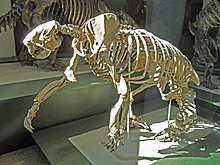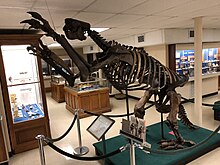
Megatherium is an extinct genus of ground sloths endemic to South America that lived from the Early Pliocene through the end of the Pleistocene. It is best known for the elephant-sized type species M. americanum, sometimes known as the giant ground sloth, or the megathere, native to the Pampas through southern Bolivia during the Pleistocene. Various other smaller species belonging to the subgenus Pseudomegatherium are known from the Andes.
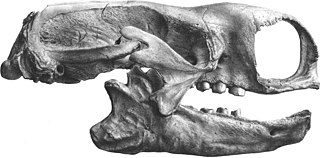
Mylodon is a genus of extinct ground sloth belonging to the family Mylodontidae, known from southern South America. With a total length of 3 to 4 m and a body mass of 1-2 tonnes, it is one of the largest mylodontids.

Vertebrate paleontology is the subfield of paleontology that seeks to discover, through the study of fossilized remains, the behavior, reproduction and appearance of extinct vertebrates. It also tries to connect, by using the evolutionary timeline, the animals of the past and their modern-day relatives.

Ground sloths are a diverse group of extinct sloths in the mammalian superorder Xenarthra. Ground sloths varied widely in size, with the largest genera Megatherium and Eremotherium being around the size of elephants. Ground sloths are a paraphyletic group, as living tree sloths are thought to have evolved from ground sloth ancestors.

The Greenbrier River is a tributary of the New River, 162 miles (261 km) long, in southeastern West Virginia, in the United States. Via the New, Kanawha and Ohio rivers, it is part of the watershed of the Mississippi River, draining an area of 1,656 square miles (4,290 km2). It is one of the longest rivers in West Virginia.
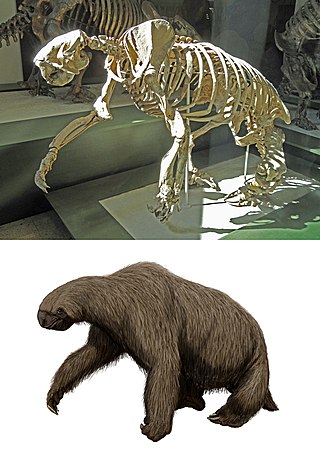
Megalonychidae is an extinct family of sloths including the extinct Megalonyx. Megalonychids first appeared in the early Oligocene, about 35 million years (Ma) ago, in southern Argentina (Patagonia). There is, however, one possible find dating to the Eocene, about 40 Ma ago, on Seymour Island in Antarctica. They first reached North America by island-hopping across the Central American Seaway, about 9 million years ago, prior to formation of the Isthmus of Panama about 2.7 million years ago. Some megalonychid lineages increased in size as time passed. The first species of these were small and may have been partly tree-dwelling, whereas the Pliocene species were already approximately half the size of the huge Late Pleistocene Megalonyx jeffersonii from the last ice age.

Acratocnus is an extinct genus of ground sloths that were found on Cuba, Hispaniola, and Puerto Rico.

Nothrotheriops is a genus of Pleistocene ground sloth found in North America, from what is now central Mexico to the southern United States. This genus of bear-sized xenarthran was related to the much larger, and far more famous Megatherium, although it has recently been placed in a different family, Nothrotheriidae. The best known species, N. shastensis, is also called the Shasta ground sloth.
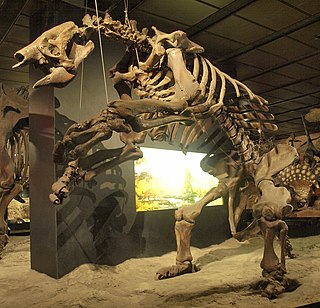
Eremotherium is an extinct genus of giant ground sloth in the family Megatheriidae. Eremotherium lived in southern North America, Central America, and northern South America from the Pliocene, around 5.3 million years ago, to the end of the Late Pleistocene, around 10,000 years ago. Eremotherium was one of the largest ground sloths, with a body size comparable to elephants, with estimated body mass of 3–6.55 tonnes (6,600–14,400 lb) and a body length of 6 metres (20 ft), being rivalled in size among ground sloths only by its close relative Megatherium. Eremotherium was widespread in tropical and subtropical lowlands and lived there in partly open and closed landscapes, while its close relative Megatherium lived in more temperate climes of South America. Characteristic of Eremotherium was its robust physique with comparatively long limbs and front and hind feet especially for later representatives- three fingers. However, the skull is relatively gracile, the teeth are uniform and high-crowned. Like today's sloths, Eremotherium was purely herbivorous and was probably a mixed feeder that dined on leaves and grasses. Eremotherium was a generalist that could adapt its diet to the respective local and climatic conditions of many regions. Finds of Eremotherium are common and widespread, with fossils being found as far north as South Carolina in the United States and as far south as Rio Grande Do Sul in Brazil, and many complete skeletons have been unearthed.

Paramylodon is an extinct genus of ground sloth of the family Mylodontidae endemic to North America during the Pliocene through Pleistocene epochs, living from around ~4.9 Mya–12,000 years ago.
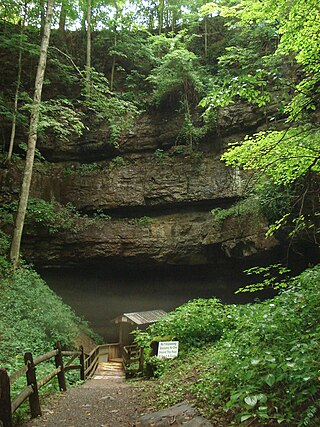
Organ Cave is a large and historic cave in Greenbrier County, West Virginia, USA. The surrounding community takes its name from the cave.
Haynes Cave is a cave within the Greenbrier River watershed in West Virginia. It sits within the complex hydrology of the historic Second Creek watershed in Monroe County.
Colonel John Stuart was a Revolutionary War commander and pioneering western Virginia settler. A veteran of the Battle of Point Pleasant (1774), he surveyed and settled the Greenbrier Valley and is known locally as the "Father of Greenbrier County". Owing to his Memoir of Indian Wars and Other Occurrences, written in 1799, he has been called "the most important chronicler of pioneer history in southern West Virginia".
The mammalian order Pilosa, which includes the sloths and anteaters, includes various species from the Caribbean region. Many species of sloths are known from the Greater Antilles, all of which became extinct over the last millennia, but some sloths and anteaters survive on islands closer to the mainland.
Organ Cave is an unincorporated community in Greenbrier County, West Virginia, United States. Organ Cave is located along U.S. Route 219 and West Virginia Route 63 at the Organ Cave, 4 miles (6.4 km) southeast of Ronceverte.
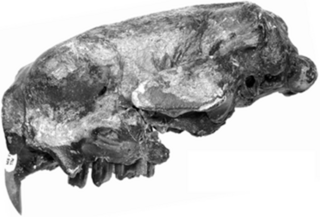
Ahytherium is an extinct genus of megalonychid sloth that lived during the Pleistocene of what is now Brazil. It contains a single species, A. aureum.
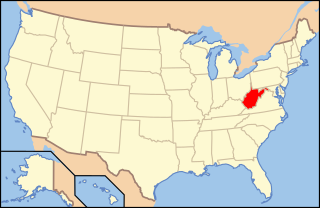
Paleontology in West Virginia refers to paleontological research occurring within or conducted by people from the U.S. state of West Virginia. West Virginia's fossil record begins in the Cambrian. From that time through the rest of the early Paleozoic, the state was at least partially submerged under a shallow sea. The Paleozoic seas of West Virginia were home to creatures like corals, eurypterids, graptolites, nautiloids, and trilobites at varying times. During the Carboniferous period, the sea was replaced by lushly vegetated coastal swamps. West Virginia is an excellent source of fossil plants due to these deposits. These swamps were home to amphibians. A gap in the local rock record spans from the Permian to the end of the Cenozoic. West Virginia was never the site of glacial activity during the Ice Age, but the state was home to creatures like mammoths, mastodons, and giant ground sloths. One local ground sloth, Megalonyx jeffersonii, was subject to the scholarly investigations of Thomas Jefferson, who misinterpreted the large-clawed remains as belonging to a lion-like predator. In 2008, this species was designated the West Virginia state fossil.
This timeline of paleontology in West Virginia is a chronologically ordered list events in the history of paleontological research occurring within or conducted by people from the U.S. state of West Virginia.
Meizonyx is an extinct genus of megalonychid ground sloth from the Pleistocene of El Salvador and southern Mexico. The type and only species, Meizonyx salvadorensis, was described in 1985 from a mandible found in Barranca del Sisimico and other remains found at Rio Tomayate in El Salvador considered to be Middle Pleistocene in age. Later, in 2021, two partial skeletons were described from Late Pleistocene aged deposits in Sistema Huautla cave in, Oxaca, Mexico, with one of these dating to around 12,562 ± 130 years Before Present. It is considered closely related to Xibalbaonyx. It is thought to be comparable or somewhat greater in size than Megalonyx jeffersonii. It inhabited relatively mountainous areas.

Ortotherium is a genus of megalonychid ground sloth from the Late Miocene Ituzaingó Formation of Entre Rios Province, Argentina. Although many species were described, the only valid species of the genus is Ortotherium laticurvatum, with many species being junior synonyms. Ortotherium is known from very fragmentary material, all of which is material from the mandible and teeth. The holotype of O. laticurvatum consists of an incomplete left dentary that had been unearthed from a series of sediments known as ‘Conglomerado osifero’ in Paraná, Argentina. Argentina paleontologist Florentino Ameghino named the species in 1885, though he would go on to name four more, invalid, species of the genus. One species however, O. brevirostrum, has been reclassified as Mesopotamocnus.
